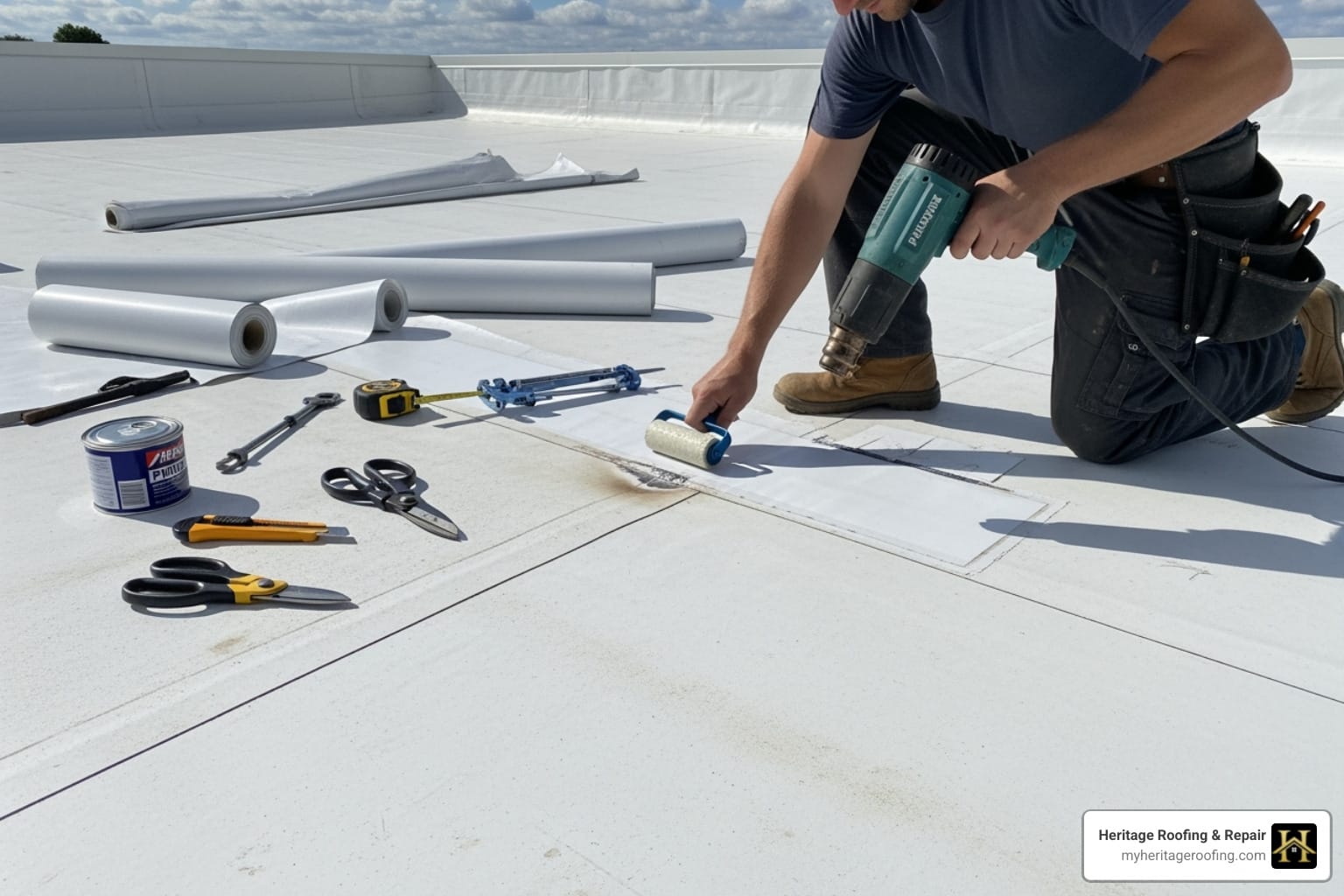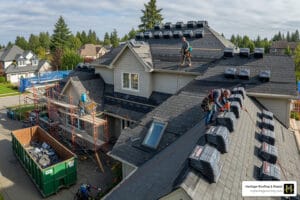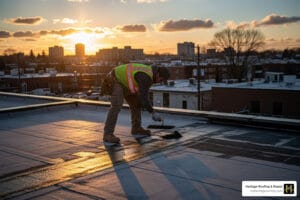Why TPO Roof Repair Matters for Your Commercial Property
TPO roof repair is essential for maintaining the integrity and energy efficiency of your commercial building. For over 50 years, Heritage Roofing & Repair has provided trusted roofing services in Northwest Arkansas, and we know that ignoring TPO issues leads to costly leaks and operational disruptions.
Quick TPO Repair Guide:
- Small punctures: Clean area, apply TPO patch with primer, and heat-weld edges.
- Seam separation: Re-weld seams or apply a cover strip.
- Blisters: Cut and drain, then patch with compatible TPO material.
- Ponding water: Address drainage and repair membrane damage.
- Professional help: Recommended for proper heat welding and to protect your warranty.
TPO roofing is popular for its cost-effectiveness and durability, but it’s vulnerable to foot traffic, debris, and weather. Understanding how to address issues with professional TPO roofing services is key to protecting your investment and maintaining your building’s energy-saving benefits.
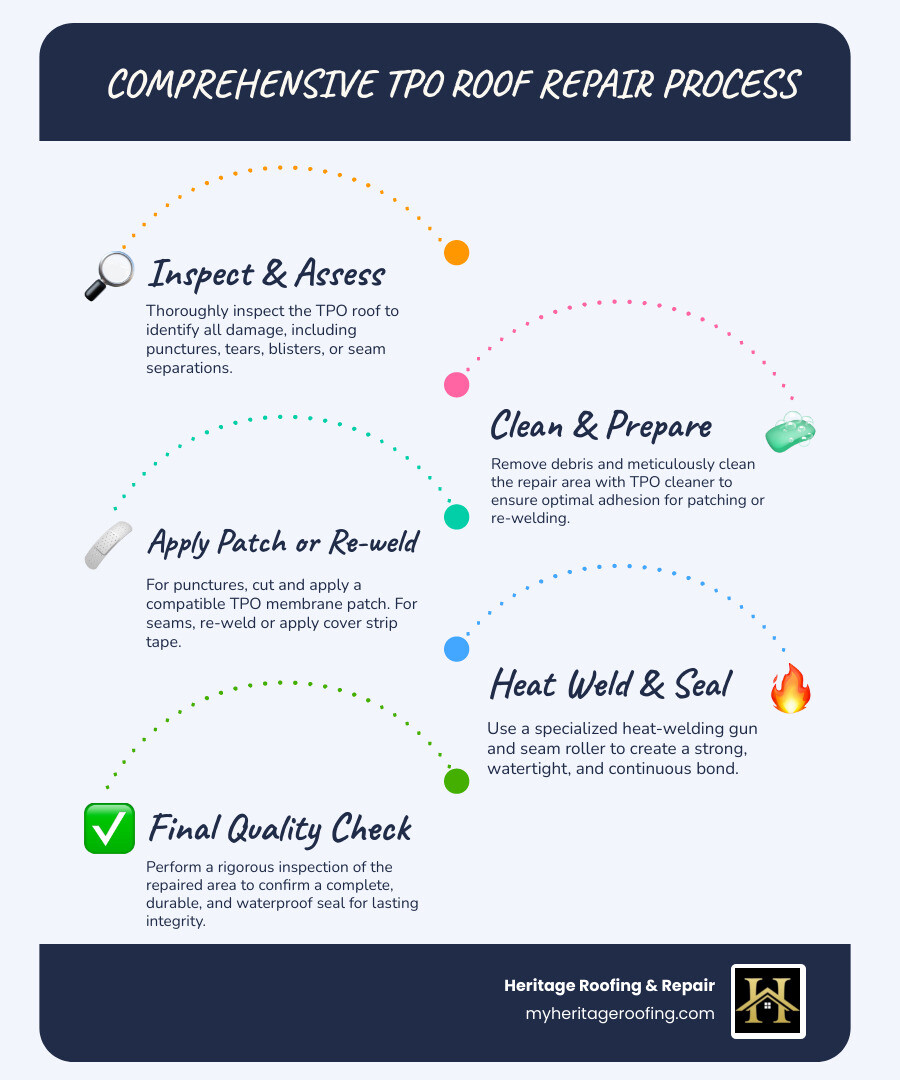
What is TPO Roofing and Why Does It Get Damaged?
Thermoplastic Polyolefin (TPO) is a leading choice for commercial roofing, valued for its toughness and flexibility. This single-ply membrane, made from polypropylene and ethylene-propylene rubber, offers impressive energy efficiency. Its typically white, reflective surface deflects sunlight, lowering cooling costs—a significant benefit for any business. TPO also provides excellent UV resistance and durability, making it a smart long-term investment.
However, even resilient materials like TPO are not immune to damage. Understanding the common culprits helps you spot problems early and avoid costly TPO roof repair emergencies.
- Foot Traffic: Maintenance crews or technicians walking on the roof can cause punctures and abrasions.
- Falling Debris: Storms can bring tree branches, hail, or wind-blown objects that tear the membrane.
- Seam Separation: The joints where TPO sheets connect can pull apart due to thermal expansion, contraction, and aging, creating a direct path for water.
- Weather & Aging: High winds, temperature swings, and years of sun exposure gradually degrade the material. A key indicator is reflectivity loss; TPO roofs can lose 20-30% of their reflectivity in just three years, reducing energy efficiency and signaling deterioration.
Common Types of TPO Roof Damage
Recognizing these common issues can save you from major headaches down the road.
- Punctures and Tears: Caused by dropped tools or sharp debris, these are obvious entry points for water but are often manageable if caught early.
- Blisters and Bubbles: Trapped air or moisture beneath the membrane creates raised, vulnerable spots that can be easily punctured.
- Separated or Failed Seams: As one of the most serious problems, failed heat-welded seams allow significant water infiltration and require professional equipment to fix correctly.
- Flashing Issues: The seals around vents, pipes, and HVAC units are critical weak points. Failed flashing is a common source of leaks.
- Ponding Water Damage: Water that sits for over 48 hours accelerates membrane breakdown and can void manufacturer warranties, highlighting the need for proper drainage.
Warning Signs: How to Tell Your TPO Roof Needs Repair
Your TPO roof will signal when it needs attention—you just have to know what to look for. Catching these warning signs early can prevent a small issue from becoming a major expense.
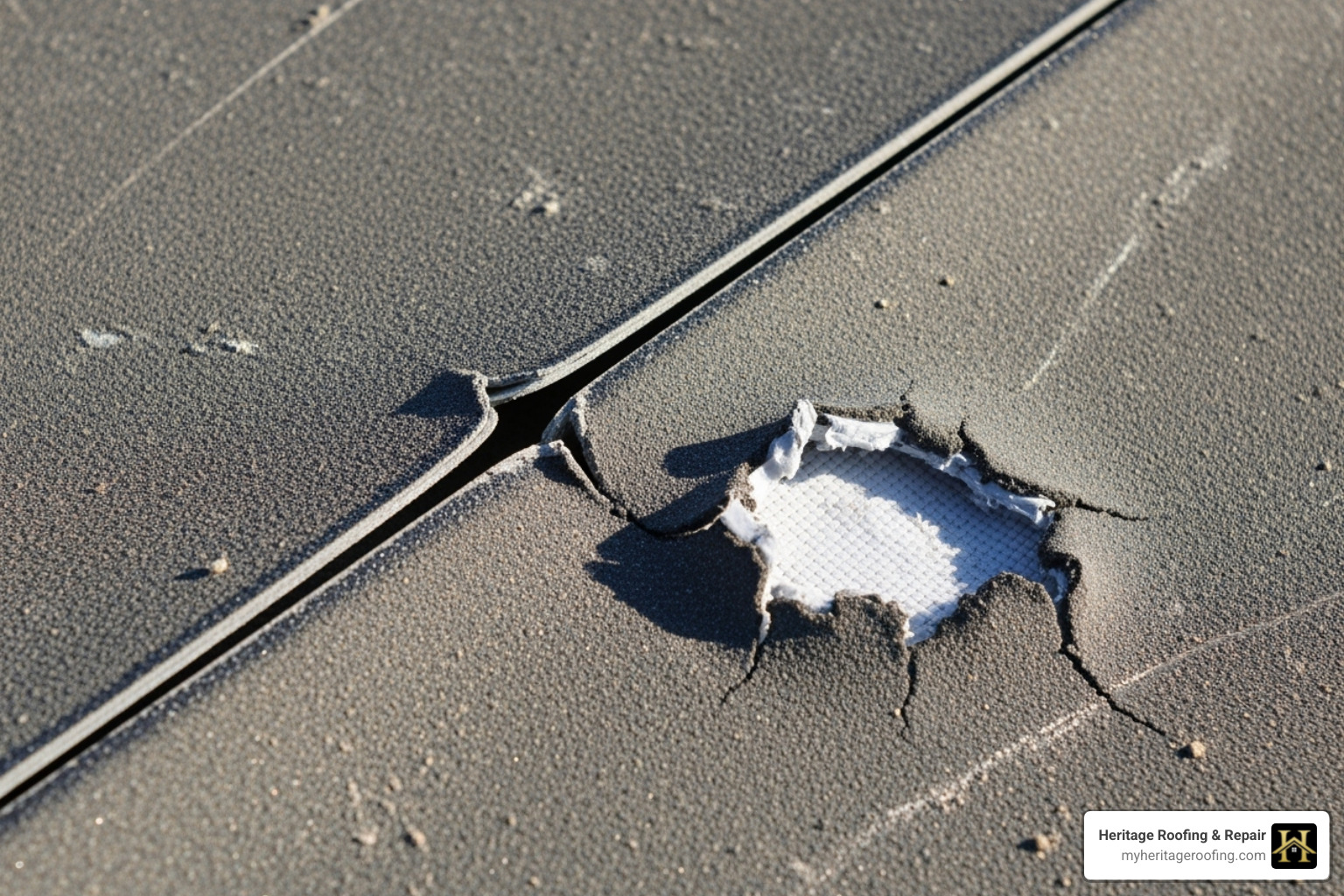
On the Roof’s Surface:
Look for obvious signs like punctures, tears, or cracks in the membrane. Check for blisters—raised, bubble-like areas where the membrane has lifted. Pay close attention to separated seams, as any gaps or lifting along these connection points are direct invitations for water. Ponding water that remains for more than 48 hours after rain indicates drainage problems that accelerate membrane decay. Also, note any significant discoloration or fading, which can suggest the material is weakening from sun exposure.
Inside Your Building:
The interior of your building often reveals the first signs of a roof problem. Water stains on ceilings or walls, active leaks, or the sudden appearance of mold growth all point to a compromised roof barrier. An unexplained spike in your energy bills can also be a red flag, as it may mean your TPO roof is losing its reflectivity and energy-saving properties.
Regular professional inspections, especially after major storms, are the best way to catch these issues early. It’s far more cost-effective to schedule a small TPO roof repair than to deal with extensive water damage later.
Your Toolkit: Materials and Tools for a Proper TPO Roof Repair
A successful TPO roof repair depends on using the right materials and tools. Using incorrect products can lead to a patch that fails quickly, compromising your roof.
The essential items for a proper repair include:
- TPO Membrane Patch: Must match your existing roof’s thickness and brand.
- TPO Seam Cleaner & Primer: These specialized chemicals are crucial for cleaning the surface and preparing it for a strong chemical bond.
- TPO-Compatible Adhesive or Cover Strip: For securing patches and seams.
- Heat-Welding Gun: A hot air gun used to fuse the TPO material, creating a monolithic surface.
- Seam Roller: Applies firm pressure after welding to ensure a complete bond and remove air bubbles.
- Basic Tools: Utility knives, scissors, cleaning rags, and safety gear (gloves, safety glasses).
The Importance of Material Compatibility
Using incompatible materials is a common cause of repair failure. TPO has a specific chemical composition and requires products designed to bond with it.
- Match Your Membrane: Different TPO formulations require specific primers and adhesives. Always follow manufacturer recommendations to ensure you are using the correct products.
- Protect Your Warranty: Most TPO manufacturers will void your warranty if unapproved materials are used for repairs. This could leave you financially responsible for any future failures.
- Ensure a Watertight Seal: True adhesion relies on a chemical bond between compatible materials. An incompatible patch may look secure initially but will likely fail under thermal stress, leading to leaks.
For any complex repairs or if you are unsure about material compatibility, consulting a professional ensures the job is done right with approved materials for a lasting, watertight result.
The Professional Process for TPO Roof Repair
While some repairs may seem simple, most TPO roof repair work requires specialized skills and equipment to ensure a lasting, watertight seal. Improper technique, such as overheating the membrane, can cause more damage. The process below outlines the general steps a certified professional follows. For complex damage, it’s always best to contact an expert.

Step 1: Inspection and Surface Preparation
A successful repair begins with a thorough damage assessment to identify all obvious and hidden issues. Once the scope is clear, the repair area is carefully cleaned of all dirt, debris, and contaminants using brushes and a specialized TPO seam cleaner. This cleaner removes oils and oxidation that can prevent a proper bond. Finally, the surface must be completely dry, as moisture is the enemy of adhesion.
Step 2: Executing the TPO Roof Repair for Punctures
For punctures, precision is key. A patch is cut from a matching TPO membrane, extending 2-3 inches beyond the damage with rounded corners to prevent future lifting. TPO seam primer is applied to both the roof surface and the patch to prepare them for bonding. The heat-welding process follows, where a specialized heat gun melts the patch perimeter and existing membrane together. Immediately after, a silicone seam roller is used to apply firm pressure, fusing the materials and removing air bubbles for a permanent, monolithic seal.
Step 3: Fixing Failed Seams
Seam failures require a similar, careful approach. The separated seam is thoroughly cleaned with TPO cleaner. Depending on the condition, the seam may be re-welded by applying controlled heat and pressure. For more significant failures, a TPO cover strip tape is applied over the entire damaged seam. This strip is heat-welded or adhered to create a new, reinforced waterproof barrier, which is then rolled firmly to ensure a complete bond.
For Professional TPO Roof Repair in Berryville, AR
When your commercial property needs TPO roof repair, you need a team that understands the technical requirements to protect your business. Our local expertise means we know the challenges Northwest Arkansas weather poses to roofing systems. Professional service ensures the job is done right, protecting your warranty and property investment.
Heritage Roofing & Repair
3458 Arkansas State Hwy 221, Berryville, AR 72616
Phone: (870) 654-1164
DIY vs. Professional Repair: A Cost and Quality Comparison
When facing a TPO roof issue, the DIY route might seem like a way to save money. However, TPO roof repair requires specialized knowledge and tools that most property owners lack. A failed DIY attempt can lead to more extensive damage, void your warranty, and end up costing far more than a professional fix.
| Feature | DIY TPO Repair | Professional TPO Repair |
|---|---|---|
| Cost | $50-200 in materials, plus risk of costly mistakes | $300-1,500+ depending on damage, includes warranty |
| Tools Required | Heat gun ($100+), seam roller ($50+), specialized cleaners | Professional-grade, calibrated welding equipment |
| Skill Level | High technical skill needed for proper heat welding | Certified technicians with specialized training |
| Time | 4-8 hours for a small repair, with no guarantee | 2-4 hours with guaranteed, lasting results |
| Warranty Impact | Almost always voids the manufacturer warranty | Maintains warranty with proper documentation |
| Quality of Seal | High risk of improper seal leading to future leaks | Professional-grade, watertight seal guaranteed |
The Hidden Risks of DIY TPO Repair
The biggest risks of a DIY repair are improper sealing from incorrect heat application and voiding your warranty. TPO manufacturers require certified professionals for repairs to keep the warranty valid. Furthermore, working on a roof with hot welding equipment presents significant safety hazards without proper training and gear.
The Professional Advantage
Hiring a professional provides access to specialized equipment and expert knowledge of TPO chemistry and application techniques. Professionals can identify underlying issues and ensure a durable, warrantied repair. Professional service protects your investment, maintains your warranty, and guarantees the job is done right the first time.
What is TPO Roofing and Why Does It Get Damaged?
As a commercial property owner, you’re likely familiar with Thermoplastic Polyolefin (TPO) roofing. This single-ply membrane is a top choice for flat and low-slope buildings, combining polypropylene and ethylene-propylene rubber for a flexible yet durable solution. Its main draw is energy efficiency; the bright white surface reflects sunlight, reducing cooling costs during hot Arkansas summers. TPO also offers excellent UV resistance and is a budget-friendly option compared to materials like PVC.
Despite its strengths, TPO is susceptible to damage over time.
- Foot Traffic: Workers on the roof can cause abrasions or drop tools, leading to punctures.
- Debris & Punctures: Storms can deposit branches or sharp objects, creating holes that compromise the waterproof barrier.
- Seam Separation: The heat-welded joints between TPO sheets are vulnerable points that can fail due to thermal stress or age, causing leaks.
- Weather & Aging: Constant exposure to wind, rain, and sun eventually weakens the membrane. TPO roofs can lose 20-30% of their reflectivity in just 3 years, a sign of material degradation that requires prompt TPO roof repair.
Common Types of TPO Roof Damage
Knowing what to look for helps you address problems before they escalate.
- Punctures and Tears: These direct entry points for water are often caused by debris or foot traffic.
- Blisters and Bubbles: Trapped air or moisture creates weak spots on the roof’s surface.
- Separated or Failed Seams: A critical failure that requires immediate professional repair to prevent widespread water damage.
- Flashing Issues: Damaged flashing around roof penetrations (vents, pipes) is a frequent cause of persistent leaks.
- Ponding Water Damage: Standing water accelerates material breakdown and can void your roof’s warranty, making proper drainage essential.
